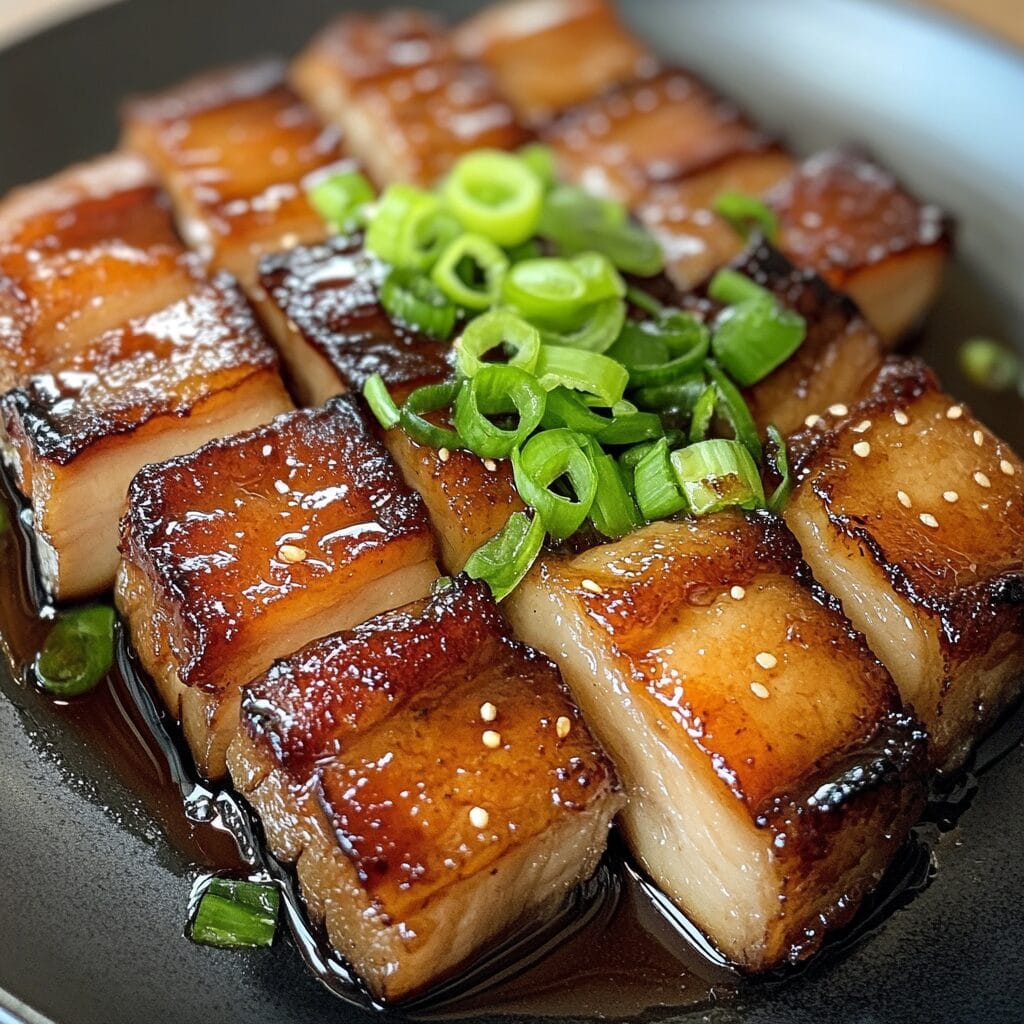Japanese chashu is a melt-in-your-mouth braised pork dish often served as a topping for ramen. Unlike its Chinese counterpart, which is typically roasted, Japanese chashu is slow-braised in a flavorful soy-based sauce, giving it a rich, tender texture. This guide will cover everything from the best cuts of meat to how to make authentic Japanese chashu at home.
What is Chashu in Japanese Cuisine?
Origins and Meaning of Chashu
- “Chashu” (チャーシュー) is derived from the Chinese word “char siu” (叉焼), meaning roasted pork.
- Unlike Chinese char siu, which is barbecued, Japanese chashu is simmered or braised.
How Chashu is Used in Japanese Cuisine
- Primarily a topping for ramen, adding umami depth to the broth.
- Served as a side dish with rice or in bento boxes.
- Sometimes included in sushi rolls (chashu maki).
Japanese Chashu vs Chinese Char Siu
Cooking Methods
| Feature | Japanese Chashu | Chinese Char Siu |
|---|---|---|
| Cooking Method | Braised in soy sauce, sake, and mirin | Roasted or grilled with a honey glaze |
| Texture | Soft, tender, and juicy | Caramelized, slightly chewy, and smoky |
| Flavor Profile | Savory and umami-rich | Sweet and slightly smoky |

Ingredient Differences
- Japanese chashu uses soy sauce, mirin, sake, and sugar.
- Chinese char siu uses hoisin sauce, honey, and five-spice powder.
Best Cut of Meat for Chashu
Pork Belly vs. Pork Shoulder
- Pork Belly (most popular) → Fatty, tender, and perfect for ramen.
- Pork Shoulder → Leaner but still flavorful; better for those who prefer less fat.
Other Cuts You Can Use
- Pork Loin → Less fat, firmer texture, great for slicing.
- Pork Butt → More marbling, good balance of fat and meat.

How to Make Authentic Japanese Chashu at Home
Ingredients for Japanese Chashu
- 1 lb pork belly (or shoulder)
- ½ cup soy sauce
- ½ cup sake
- ¼ cup mirin
- 2 tbsp sugar
- 1 cup water
- 4 cloves garlic (smashed)
- 1-inch piece ginger (sliced)
- 2 green onions
Step-by-Step Cooking Instructions
1. Roll and Tie the Pork
- Roll the pork belly into a log and secure it with kitchen twine for even cooking.
2. Sear the Meat
- Heat a pan and sear the pork on all sides until golden brown.
3. Simmer in Sauce
- Place pork in a pot, add soy sauce, sake, mirin, sugar, water, garlic, ginger, and green onions.
- Simmer for 1.5 to 2 hours, flipping occasionally.
4. Rest and Slice
- Let the pork cool in the sauce for maximum flavor absorption.
- Slice thinly before serving.
Chashu Variations and Substitutes
Different Cooking Styles
- Rolled Chashu → Traditional method for ramen.
- Block Chashu → Cut into cubes, often stir-fried or grilled.
Best Substitutes for Chashu
- Braised Chicken Thighs → A leaner alternative with similar flavors.
- Seitan or Tofu Chashu → Great plant-based options.
- Duck Breast → A rich, flavorful alternative for a gourmet twist.
How to Store and Reheat Chashu
Best Ways to Store Chashu
- Refrigerate: Store in an airtight container with the braising liquid for up to 5 days.
- Freeze: Wrap tightly and store for up to 2 months.
How to Reheat Chashu
- Microwave: Heat in short bursts with some braising liquid to prevent drying out.
- Pan-fry: Sear lightly to restore crispiness.
Perfect Ramen Pairings with Chashu
Best Ramen Types for Chashu
| Ramen Type | Flavor Profile |
|---|---|
| Tonkotsu Ramen | Creamy, rich pork bone broth |
| Shoyu Ramen | Soy sauce-based, slightly salty |
| Miso Ramen | Deep umami flavors, pairs well with fatty chashu |
Toppings That Go Well with Chashu
- Soft-boiled eggs (ajitama)
- Bamboo shoots (menma)
- Green onions
- Seaweed (nori)
FAQs
1. What is chashu in Japanese?
Chashu is a braised pork dish commonly used as a topping for ramen. It’s simmered in soy sauce, sake, mirin, and sugar for a tender, umami-rich flavor.
What is the difference between Chinese chashu and Japanese chashu?
Chinese chashu (char siu) is roasted or grilled with a sweet glaze, while Japanese chashu is braised in a savory soy-based sauce, making it softer and more tender.
What is the best cut of meat for chashu?
Pork belly is the most popular cut for chashu because of its high-fat content, which makes it tender and flavorful. Pork shoulder is a leaner alternative.
What is a substitute for chashu?
For a leaner option, braised chicken thighs work well. Vegetarians can use seitan or tofu chashu, while duck breast adds a gourmet touch.
Conclusion
Japanese chashu is the ultimate ramen topping, offering a rich, savory bite that melts in your mouth. Whether you prefer pork belly for its luscious fat or a leaner alternative, making chashu at home is easier than you think. Pair it with your favorite ramen for a restaurant-quality experience.
Print
Japanese Chashu – Braised Pork Belly
- Total Time: 2 hours 15 minutes
- Yield: 4 servings 1x
Description
Japanese chashu is a melt-in-your-mouth braised pork dish often served as a topping for ramen. Unlike its Chinese counterpart, which is typically roasted, Japanese chashu is slow-braised in a flavorful soy-based sauce, giving it a rich, tender texture.
Ingredients
- 1 lb pork belly (or shoulder)
- ½ cup soy sauce
- ½ cup sake
- ¼ cup mirin
- 2 tbsp sugar
- 1 cup water
- 4 cloves garlic (smashed)
- 1-inch piece ginger (sliced)
- 2 green onions
Instructions
- Roll the pork belly into a log and secure it with kitchen twine for even cooking.
- Heat a pan and sear the pork on all sides until golden brown.
- Place pork in a pot, add soy sauce, sake, mirin, sugar, water, garlic, ginger, and green onions.
- Simmer for 1.5 to 2 hours, flipping occasionally.
- Let the pork cool in the sauce for maximum flavor absorption.
- Slice thinly before serving.
Notes
Pork belly is the best cut for a tender, flavorful chashu. Store in an airtight container with the braising liquid for up to 5 days or freeze for up to 2 months.
- Prep Time: 15 minutes
- Cook Time: 2 hours
- Category: Main Course
- Method: Braising
- Cuisine: Japanese
Nutrition
- Serving Size: 1 portion
- Calories: 350
- Sugar: 5g
- Sodium: 800mg
- Fat: 25g
- Saturated Fat: 9g
- Unsaturated Fat: 14g
- Trans Fat: 0g
- Carbohydrates: 6g
- Fiber: 0g
- Protein: 24g
- Cholesterol: 90mg
Keywords: chashu, braised pork, ramen topping, Japanese cuisine

